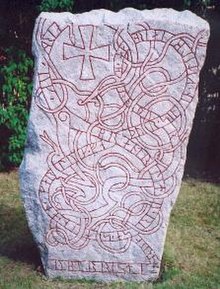Uppland Runic Inscription Fv1976 107
| Uppland Runic Inscription Fv1976 107 | |
|---|---|
 | |
| Created | eleventh century |
| Discovered | Uppsala Cathedral, Uppsala, Uppland, Sweden |
| Rundata ID | U Fv1976;107 |
| Runemaster | Öpir |
This runic inscription, designated as U Fv1976;107 under the Rundata catalog, is located at the Uppsala Cathedral in Uppsala, Sweden.
Description
The runic inscription consists of text inscribed on a thin intertwined beast with one upper loop around a
The runic text is missing a pronoun, the word "his" before "brother." Öpir is known to have left off
Of the personal names listed in the runic inscription, Ketilbjôrn means "Kettle Bear" and Karlungr, originally used as a nickname, means "Young Man."[2]
The Rundata designation for this Uppland inscription, U Fv1976;107, refers to the year and page number of the issue of
Inscription
…-arn
…[bj]ǫrn(?)
·
uk
ok
·
brantr
Brandr
litu
létu
·
risa
reisa
·
stin
stein
·
at
at
·
karluk
Kǫrlung,
·
faþur
fǫður
·
sin
sinn,
in
en
·
kitilbiarn
Ketilbjǫrn
at
at
·
broþur
bróður.
ybir
Œpir
risti
risti
run
rúnar.
…-bjǫrn and Brandr had the stone raised in memory of Karlungr, their father; and Ketilbjǫrn in memory of (his) brother. Œpir carved the runes. [3]
See also
- List of runestones
- Runic alphabet
References
- ^ ISSN 1404-9430. Retrieved 2010-01-10. p. 106–108.
- ^ Cleasby, Richard; Vigfússon, Guðbrandur (1878). An Icelandic-English Dictionary. Clarendon Press. pp. 331, 337.
- ^ "Runic inscription U Fv1976;107". Scandinavian Runic-text Database (2020 ed.). Uppsala University: Department of Scandinavian Languages. Retrieved Feb 25, 2024.
External links
- Riksantikvarieämbetet - photograph of inscription
